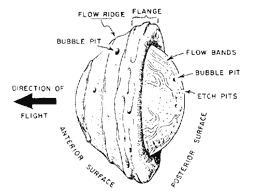 |
Science Frontiers ONLINE No. 67: Jan-Feb 1990 |
|
|
Australasian tektites coughed up by a moon of jupiter?
The Australasian tektites are glassy blobs found on or near the surface of the ground from the Philippines, through southeast Asia, all the way to Tasmania. Similar but much smaller "microtektites" appear in deapsea de posits in the adjacent oceans. Radiometric and fission-track dating indicate that the tektites solidified about 700,000 years ago. Yet, their geological age, as measured by the age of the terrestrial sediments in which they are found, is only a few thousand years. This great disparity in age engendered a confrontation between geologists and geophysicists. The latter insisted on their 700,000-year figure; the former said "maybe so" but the tektites are still found only in very young, superficial sediments. The point here is that time-of-solidification may not be the same as time-of-fall.
At stake is the prevailing theory, now dogmatically proclaimed, that tektites are created when a large asteroid impacts the earth, ejecting molten droplets of rock which shower back to earth as solidified tektites. No one has ever found a suitably large crater ( 200 miles in diameter) assignable to the Australasian tektite strewn field. Nevertheless, the impact model prevails; and the young geological age of the tektites is dismissed as erroneous.
A Soviet scientist, E.P. Izokh, has recently proposed a radically different scenario that would produce both the young and old dates. If a moon, or Jupiter, or some similar body, explosively ejected the glassy tektites, embedded in an icy cometary body some 700,000 years ago, the tektites could, after cruising through space for millenia, have fallen to earth recently and over a wide area. Thus, both geologists and geophysicists would be satisfied! (Sullivan, Walter; "New Answer Proposed for Tektites: A Comet," New York Times, November 28, 1989. Cr. R. Adams)
Comment. Russian scientists have long suggested that comets may be ejected from solar-system bodies and have been laughed at by American scientists for their trouble!
Reference. For more on tektite anomalies, refer to category ESM3 in our catalog: Neglected Geological Anomalies. Ordering information here.
 | An Ablation-sculpted australite, one type of Australian tektite. |